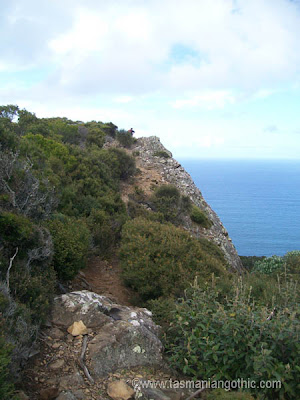This is Cape Raoul.
Some time about the turn of the last century. It's probably one of
Tasmania's most photographed bits of coastline; not hard to see why! This is a much-reproduced Beattie photograph and this particular copy with caption appears in Tasmania's Strange Story, "issued under the Auspices of the Come to Tasmania Organisation by Leslie Norman, Sec." in 1928 "to attract a greater number of tourists for the season".
The photograph above is a typical view of Cape Raoul's unmistakable dolerite columns. Dolerite, according to
J.R. Skemp, my favourite authority on things Tasmanian, formed from
molten magma, which intruded into sedimentary sandstones in the
Jurassic era.
"The cooling of the
dolerite sometimes made it split into vertical sections which were
exposed in lifted blocks, and produced what is called 'columnar'
dolerite. Good examples of this columnar dolerite are the Organ Pipes
on Mt Wellington, Cape Raoul on Tasman peninsula and the sides of the
Cataract Gorge, Launceston." . . . he goes on to point out that it
is this dolerite that makes the "Tasmanian landscape so different
from that of the rest of Australia and give[s] it an added
attraction for tourists. The nearest similar dolerite rocks are in
South Africa and Antarctica."
In the early days of settlement some of the English had little respect for the landscape.
In the nineteenth century the crew of a Royal Navy ship amused themselves using the
columns of Cape Raoul for target practice; they did a bit of damage
before people objected.

The incident caused such indignation that the only newspaper report I have found so far is an obscure reference to "that event" several years previously. The writer assumes everybody knew what he was talking about. I'm still trying to discover the name of the ship involved!
If you compare the Beattie photo above with a more recent one you'll see a few more columns.
Fortunately, not all their shots hit the target.
In the 1990s a Hobart Walking Club member discovered an unexploded shell further along the coast; military people blew it up to make it safe, but it's
still there if you know where to look.
Some of these
photographs are on my desktop at present; I get vertigo every time I
switch on my computer.
reference:Skemp, J.R.Tasmania
Yesterday and Today. Melbourne. Macmillan and Co Ltd. 1959














 The incident caused such indignation that the only newspaper report I have found so far is an obscure reference to "that event" several years previously. The writer assumes everybody knew what he was talking about. I'm still trying to discover the name of the ship involved!
The incident caused such indignation that the only newspaper report I have found so far is an obscure reference to "that event" several years previously. The writer assumes everybody knew what he was talking about. I'm still trying to discover the name of the ship involved!
 The incident caused such indignation that the only newspaper report I have found so far is an obscure reference to "that event" several years previously. The writer assumes everybody knew what he was talking about. I'm still trying to discover the name of the ship involved!
The incident caused such indignation that the only newspaper report I have found so far is an obscure reference to "that event" several years previously. The writer assumes everybody knew what he was talking about. I'm still trying to discover the name of the ship involved!



I would like to use your image of the unexploded shell on Salters Point in a book I am writing. Please contact me at tstredwick@velosmith.com.au
ReplyDeleteCheers
Tim